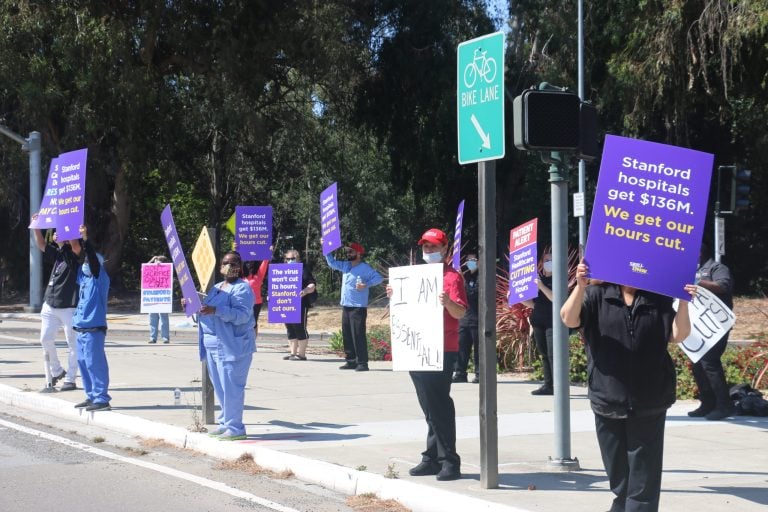Healthcare workers returned to El Camino Real on Thursday to continue protests against pay cuts and furloughs from Stanford Health Care’s Temporary Workforce Adjustment (TWA) program.
Healthcare workers, supported by family members and employees from the SEIU-United Healthcare Workers West (SEIU-UHW) union, gathered on the intersection of El Camino Real and Sand Hill Road near Stanford Hospital at 2:30 p.m to wave placards at passing traffic. Additional healthcare workers in scrubs filtered in throughout the afternoon.
The demonstration comes two weeks after an initial protest at the same location. Stanford Health Care’s TWA program, implemented in late April in response to economic pressures from COVID-19, requires employees to either furlough, take paid time off (PTO) or accept a 20% pay cut. Healthcare workers have complained about feeling forced into negative PTO as a result, which could leave workers without paid leave for “years.”
According to Stanford Health Care spokesperson Julie Greicius, Stanford Health Care’s TWA will end on June 20 for SEIU employees and July 4 for non-represented employees.
“Our priorities have been to stand with our people, preserving their jobs and earnings,” Greicius wrote in a statement to The Daily. “We have worked to match our daily workforce to demand across the organization … utilizing paid time off to keep everyone employed and our staff at full wages with benefits intact, and providing options to maintain their earnings.”
“SEIU employees are not being offered the option of a pay cut as part of the TWA, because we are abiding by the negotiated contract,” Greicius added. “Their hourly rate remains the same, and for their reduced hours they have the choice to use paid time off (PTO).”
According to Linda Cornell, a unit secretary at Stanford Hospital, Stanford Health Care has repeatedly refused to bargain with staff about the TWA. A unit secretary “functions as a member of the patient care team by providing clerical support,” according to a job listing by Stanford Health Care.
Healthcare workers asked to negotiate with Stanford “when they [the University] first implemented [the adjustment program],” Cornell said. “We’ve asked repeatedly several times since then, and they’ve continued to refuse.”
“We have their [Stanford Health Care’s] attention,” said surgical technician Amanda Arrambide. “We know that our presence here and trying to motivate people to stand up against them is bothering them, so I see that as progress.”
Arrambide also alleged that Stanford Health Care management had attempted to discredit SEIU-UHW’s efforts.
“We send out texts to kind of inform people of what’s going on in the union,” Arrambide said. “One of the members of [Stanford Hospital] responded back saying, ‘my manager is telling me that the union actually agreed to this and that you guys are kind of letting it happen’… it’s just kind of crazy how management is kind of stooping to that level to lie to people to lose faith in our own union.”
Greicius did not comment on this allegation.
One month into Stanford Health Care’s adjustment program, healthcare workers also expressed concerns that reductions in staffing and work shifts were compromising the quality of care for patients at Stanford’s hospitals.
“I work with teenagers and young adults who have eating disorders, and I’ve been doing it for 35 years,” said youth counsellor Kathy Haalck. “Today I’m taking a mandatory day off … and a registry or agency person is taking my place … It is definitely decreasing the quality of my kids’ care.”
“The other day we had a patient that was in an isolation room,” Cornell said. “It took like six or eight hours for us to be able to get a housekeeper to get in there to remove the trash, because there weren’t enough housekeepers. Maybe a housekeeper might have one floor to cover, and now they’ll have several floors to cover.”
Stanford Health Care “resumed nearly all procedures on May 4,” Greicius wrote, attributing this decision to “widespread testing of our workforce that showed exceptionally low infection rates and therefore a safe environment for staff and patients.”
“We have taken every measure to ensure the safety of our staff and patients as we reactivate operations, and to continue to provide the safest, highest quality care to our community,” Greicius added.
Arrambide said that Stanford’s communication with healthcare workers has been unclear on when normal pay would resume.
“When they rolled it out, they said it could be extended or shortened, but there hasn’t been any talk of doing away with it,” Arrambide said.
But Greicius contested this.
“We communicated the expected end date and the prospect of the time frame changing to all employees through manager meetings and on the first page of the FAQs about the TWA program available on Stanford Health Care’s intranet,” Greicius wrote in an email to The Daily. “We expect the end dates to remain as scheduled and hope that any employee looking for facts about the TWA program will reach out to their manager and review the FAQs.”
Arrambide and Cornell said they will continue to push for a dialogue with Stanford Health Care.
“We need to hear from them [about] when this is going to be over because it’s not fair,” Arrambide said. “We know that they have money.”
“We’re not going to stay quiet about this,” Cornell said. “We’re always asking them to … respect us and meet with us. We’re gonna keep pushing for that, and if they won’t speak to us, we’re going to speak to the public.”
Contact Daniel Wu at dwu21 ‘at’ stanford.edu.
